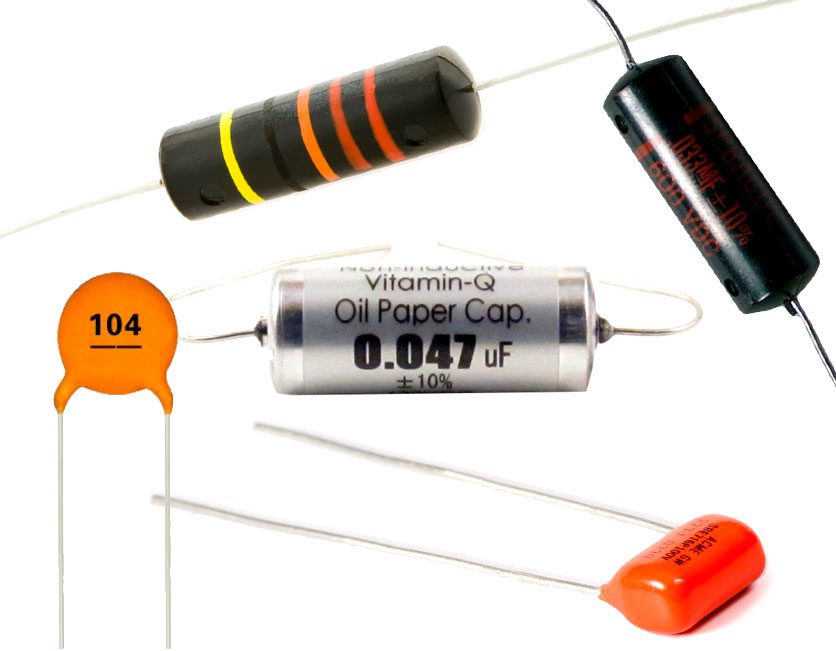
There a few topics more likely to cause arguments on guitar forums than capacitors (caps). So, let’s have a look at what’s really going on.
In a guitar signal path (note that I am not using the term ‘circuit’ – more on that later), capacitors are usually employed as a ‘high pass filter’. This is useful in a guitar if you want to vary the tone coming from your pickups.. By sending part of your signal to ground via a potentiometer you can use caps to variably filter out the high end and this is generally what they are used for in guitars.
This brings us on to the most contended area of the subject of capacitors – materials. Capacitors can be constructed of a few different types of materials: paper-in-oil (PIO); film (polypropylene, polysyrene or polyester); and ceramic are the most usual formats. There are two ends of the spectrum here. Some people will say that only old-style PIOs such as ‘bumblebees’ sound good in guitars. Alternatively, it is often argued that it makes no difference what type of material a capacitor is made of and that it is only the value that counts. This is a belief most strongly held by trained electronics experts. The truth of the matter lies somewhere in between.
While it is true that in an electrical circuit the material of a capacitor has no relevance in its ability to act as a capacitor in the traditional sense, and the electronics boffins can produce formula to demonstrate this, a capacitor in a guitar is part of a signal path, not an electrical circuit. In other words, it isn’t doing at all the same job in a guitar. What is passing through the wires in your guitar is a current which is acting an analogue of the vibration of the strings, a conversion of very complex frequencies, overtones and tones into an electrical signal, which will be converted back into sound by your amplifier. The capacitor filters out some of those signal frequencies via the material of its construction, and the frequencies and tones that material allows though and removes from the signal path can vary. You can check this for yourself by setting up some wire and crocodile clips and connecting different types of capacitor of the same value to a pot. Provided the caps are genuinely of the same value (which can be checked beforehand with a meter) subtle differences in tone can be heard. Some people will argue that this is ‘confirmation bias’ (you expect to hear something and you do) but I have blind tested this with clients.

People who argue that only old capacitors taken out of radios or expensive Russian PIOs will make your guitar sound good are probably trying to sell you expensive, old capacitors. Sometimes a Russian PIO will sound great but sometimes a film cap costing a few pennies sounds better. Polypropylene Sprague Orange Drops (and there are plenty of fakes of those out there) sell for alot more than much cheaper film capacitors but they may not be any better and with some guitars sound worse (although they sometimes are just right for a particular guitar). Mullard ‘mustard’ caps are prized by some, but I have found them far to dark to use in a guitar.
Generally, I don’t recommend any particular type of capacitor as each guitar responds differently to different materials and values, but a polystyrene film capacitor of 10 nanofarads is where I will start or what I will use if a client expresses no preference. I rarely go up to 47 nanofarads or beyond – there just isn’t usually a call for that much high tone to be rolled off and it usually results in the tone pot acting more like a volume control. I will never use ceramic capacitors in a guitar. Some people will argue that is OK, because both Fender and Gibson use them in theirs. The reason the big manufacturers use them that is that ceramics are a cent each and even in bulk a film cap will be 10 to 100 times as costly. If you are making thousands upon thousands of guitars every year, the savings from using ceramic caps are significant. It’s not an aesthetic decision, it’s an economic one, and, despite using ceramics in most of their instrument, even Gibson say that the material makes a difference.
A lot of people will argue that when your tone potentiometer is set at 10, the cap is having no effect on tone. This is ignoring the physical fact that the potentiometer is connected to ground via its wiper all the way across the range from 1 to 10. It’s true the graphite screen in the pot is very narrow at 10 but I will challenge anyone with a decent pair of ears not to notice the difference between a tone pot working at 10 and a pickup disconnected from a tone pot. You can hear the difference with a traditionally-wired stratocaster. That sharp treble tone on the bridge pickup (compared to middle and neck) is because that pickup is not connected to a tone pot. You can buy ‘no load’ potentiometers, if you want that tone, which are genuinely disconnected from the signal path at 10.
The voltage of a capacitor has no impact on its tone. Most of the ones found in guitars are around 200v and that’s just fine. The voltage going through your guitar is around 0.25v maximum. A larger value cap will just take up more space in your control cavity. Of course, if all you have is a massive 600v cap, there isn’t any reason not to use it as long as it physically fits. The format of the capacitor makes no diference either. You can use caps with radial or axial leads or ‘box’ capacitors.
So, that’s my musings on tone capacitors in conventional use. In some circumstances, a capacitor will be used to brighten up a pickup by placing it in between the pickup and the controls but you will want to use a very high value for this and it’s an esoteric solution for pickups which are too dark. Capacitors are also used more commonly in treble bleeds, and there is another blog on this website on this subject.
I hope you found this article useful. If you need to discuss anything cap-related to do with your guitar drop us a line.
If you’ve got a guitar problem you’d like us to have a look at, contact us for a free assessment.
